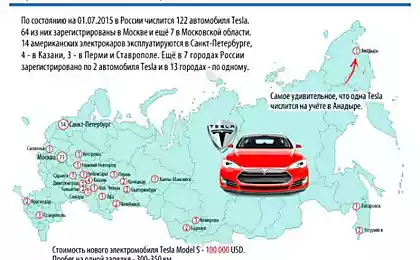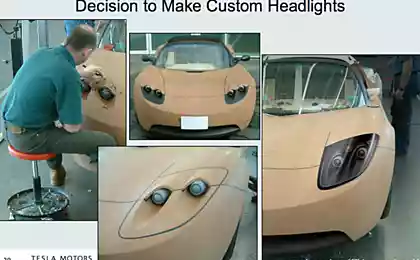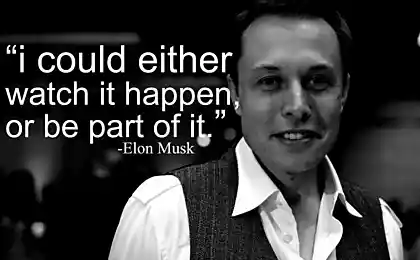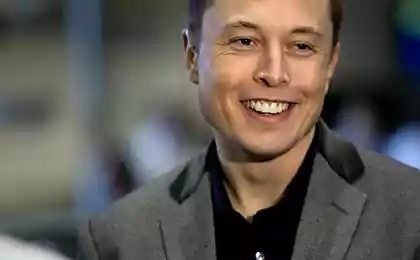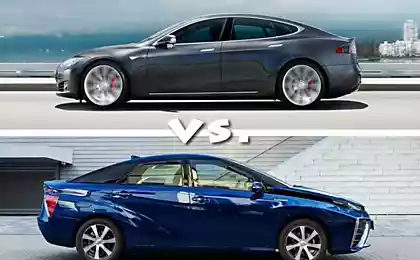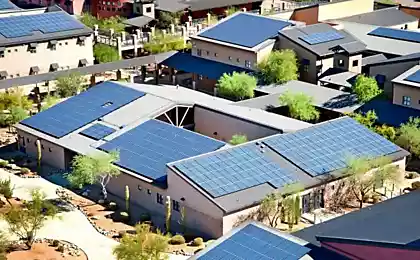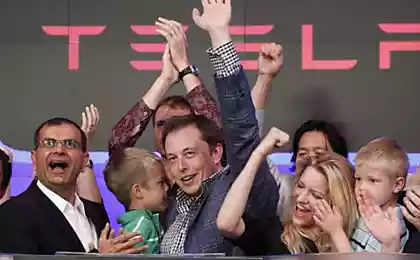1135
Tesla plans to change the energy infrastructure in the world?
Batteries are able to change the traditional energy systems in a way that would be possible to create intelligent systems and microsystems.
Executive Director Tesla Elon Musk last week officially announced that his company producing electric vehicles opens a new direction - the production of batteries. Tesla Energy, a new separate division of Tesla Motors, are now engaged in the production of lithium-ion batteries for consumer use and for business that can be used in addition to solar and wind electrical installations, as well as to provide additional reliability for customers connected to the conventional power grid. < br />
But over the next few years of consumer batteries Tesla category are not enough to bring a significant financial impact in the domestic sector in many countries outside the United States. If the regular electricity in your state is not worth too much (as seen in Hawaii), in places where the sun sets every day, will be less expensive to use traditional power grid, especially if the municipal network buy surplus electricity generated by solar installations (as, e.g., California). And even if consumers can use batteries as a backup power supply in case of an emergency power outage for a few days the generator is able to develop more power for less money. So what is the business model of Tesla Energy?
Batteries consumer class have attracted the bulk of media attention, but, as Mr. Musk said at a teleconference devoted to financial performance, the company Tesla Energy in the near future plans to shift the focus on the business sector and the municipal sector. As he put it: "We expect that the largest share of sales of stationary electricity storage devices will be in the utility and industrial models».
This is the direction that will make money. Musk is confident that Tesla will be engaged in the installation of batteries for large enterprises and public institutions, and the installation and maintenance of installations Powerwall consumer class will be transferred to contractors. This may mean that the Tesla Energy will earn a low-power battery-less.
The focus on the municipal sector is also important, if Tesla Energy plans to "radically change the way energy use worldwide terawatt scale", as stated by Mr. Musk during the presentation of new batteries last week. To do this, Tesla should do something more than just a consumer installation for storing electricity - they have to change our traditional, an aging power supply system at the municipal level.
New batteries come with a built Tesla control software and the ability to connect to the Internet, "allowing you to create intelligent microsystems", as stated by Mr. Musk during the story about the principles of the planned fundamental changes. To date, none of the cities in the United States has no power controlled such microsystems, with the exception of pilot programs, so that the enthusiasm of Elon Musk makes us wonder: how did the future looks micro power, and what role it will play in the new batteries Tesla utility class ?
The best place for these networks - small islands h4> Senior Research Scientist Pacific Northwest National Laboratory (PNNL) Rob Pratt says that the best place is the place of accommodation microsystems with a small number of consumers, who together hold a variety of local energy resources - such as, for example, a campus or industrial park. This allows for the isolation of microgrids public grid and from neighboring microgrids in case of emergency or other cases.
Reasonable pricing for electricity h4> Flexible consumer load - for example, air conditioners, which can turn off the compressors for a short time during peak loads on the network - can give a similar result.
Tesla: management of relations between companies and electricity suppliers h4> The above-described method is applied in full in the vineyards Jackson Family Wines, the family vineyards in California, which have the largest of all installed by Tesla Energy electric power plants: 21 electrical installation utility class that can provide extra power at 8, 4 MWh (ie 8400 kWh) in six wineries in Northern California. Julien Zhervro, Senior Manager Development Jackson Family Wines, told the publication Ars that at the time when the company Tesla got in touch with their company, they have collaborated with the Pacific Gas & Electric (PG & E) in the implementation of the basic differentiated strategy charging.
The last fight - he was the most difficult h4> Despite the fact that microgrids and differentiated rates are attractive, there's an obstacle in their implementation. The corresponding energy suppliers may not agree to invest in more complex schemes that make it difficult for them to generate revenues.
Executive Director Tesla Elon Musk last week officially announced that his company producing electric vehicles opens a new direction - the production of batteries. Tesla Energy, a new separate division of Tesla Motors, are now engaged in the production of lithium-ion batteries for consumer use and for business that can be used in addition to solar and wind electrical installations, as well as to provide additional reliability for customers connected to the conventional power grid. < br />
But over the next few years of consumer batteries Tesla category are not enough to bring a significant financial impact in the domestic sector in many countries outside the United States. If the regular electricity in your state is not worth too much (as seen in Hawaii), in places where the sun sets every day, will be less expensive to use traditional power grid, especially if the municipal network buy surplus electricity generated by solar installations (as, e.g., California). And even if consumers can use batteries as a backup power supply in case of an emergency power outage for a few days the generator is able to develop more power for less money. So what is the business model of Tesla Energy?
Batteries consumer class have attracted the bulk of media attention, but, as Mr. Musk said at a teleconference devoted to financial performance, the company Tesla Energy in the near future plans to shift the focus on the business sector and the municipal sector. As he put it: "We expect that the largest share of sales of stationary electricity storage devices will be in the utility and industrial models».
This is the direction that will make money. Musk is confident that Tesla will be engaged in the installation of batteries for large enterprises and public institutions, and the installation and maintenance of installations Powerwall consumer class will be transferred to contractors. This may mean that the Tesla Energy will earn a low-power battery-less.
The focus on the municipal sector is also important, if Tesla Energy plans to "radically change the way energy use worldwide terawatt scale", as stated by Mr. Musk during the presentation of new batteries last week. To do this, Tesla should do something more than just a consumer installation for storing electricity - they have to change our traditional, an aging power supply system at the municipal level.
New batteries come with a built Tesla control software and the ability to connect to the Internet, "allowing you to create intelligent microsystems", as stated by Mr. Musk during the story about the principles of the planned fundamental changes. To date, none of the cities in the United States has no power controlled such microsystems, with the exception of pilot programs, so that the enthusiasm of Elon Musk makes us wonder: how did the future looks micro power, and what role it will play in the new batteries Tesla utility class ?
The best place for these networks - small islands h4> Senior Research Scientist Pacific Northwest National Laboratory (PNNL) Rob Pratt says that the best place is the place of accommodation microsystems with a small number of consumers, who together hold a variety of local energy resources - such as, for example, a campus or industrial park. This allows for the isolation of microgrids public grid and from neighboring microgrids in case of emergency or other cases.
According to Mr. Pratt, ideal microgrids begins with the use of diesel generators or generators powered by natural gas, as well as a sufficient amount of renewable energy to provide ecological network - at least at the current level of standard.
"I believe that the best next step would be to use allocated to the diesel generator of thermal energy", - said Partt - "If you use the released heat energy can be an effective way to get energy from the fuel to 70-80%, while in the Currently it is about 40% ».
Batteries can be used in the presence of existing microgrids. If Micronet partly uses energy renewable energy, such as solar energy, batteries public class can afford to keep a certain amount of electricity produced for use during adverse periods, as well as domestic battery models. This gives the operator microgrids some extra room for maneuver and may reduce the need for additional generators.
"In addition, the batteries can be useful as a buffer," - says Pratt - "Diesel generators do not work very effectively at half load; optimum load value for them is 70 percent. At this load they have greater efficiency and cause less damage to the environment. " The transitional periods in the mornings and evenings, "When it comes time to turn another generator, but you would not want to do that," You can turn the battery.
"Including the battery for a while, I can afford to keep generators running speed, at which they reach maximum efficiency," - says Pratt.
In addition, the battery allows you to overcome the short-term transients in frequency in older rotary generator in which output fluctuates a few seconds before the establishment of a stable operation. If there is such a thing, "the battery can provide fast enough, and compensating for such smoothing transients" - says Pratt.
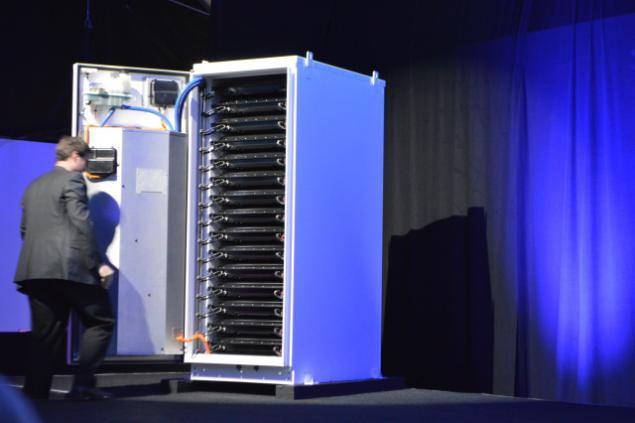
To enable communication between different micro-network, you need the software. Here on the scene, companies such as RTI (Real Time Innovations). David Barnett, vice president of products and marketing, said that at the moment RTI develops and sells analytical software that allows to predict the demand for electricity in real time, that is, allowing the operator to microgrids to decide how much and what kind of energy is required in the near future .
This is a very difficult task. "If anyone includes the installation of a network of production Tesla, this leads to the peak in the network», ¬- said Mr. Barnett, and has a micro-network "time to react just about ten milliseconds." Software production RTI combines real-time data and predictive analytics to provide utility substation opportunity to respond to significant leaps in a short time.
Batteries can provide the necessary responsiveness microgrids for such races. "Today, many of the decisions [on the switching of power lines] are taken centrally," says Mr. Barnett. However, in the case of microgrids "Batteries [are] at a substation, so that they are distributed around the city. All the computing power located right in the substation and provide a link between it and the consumer, "- he adds.
All this - the signs of a new, more efficient electricity grid, in contrast to the old design the network that we have at the moment - and it can be the same, if not more environmentally friendly.
"Batteries can respond to emerging transients different time scale, ranging from seasonal and ending minutes and seconds, and counteract them, which complicates the management of the network (and increases its value)," - wrote Mr. Pratt in the covering letter to Ars.
However, the battery - not the only tool that can provide it.
Reasonable pricing for electricity h4> Flexible consumer load - for example, air conditioners, which can turn off the compressors for a short time during peak loads on the network - can give a similar result.
Another way in which utilities can create a flexible consumer load, is the introduction of some analog differentiated tariffs depending on demand. When differentiated charging instead of fixed rates per unit of electricity consumed price for it varies according to demand. This allows consumers to reduce energy consumption during periods when the rate is highest.
Currently, differentiated tariffs are investigated and verified by Mr. Pratt and his research group at PNNL, who are developing the technology that allows to compare statistical data on energy consumption information on the cost of production and transmission of electricity at a particular time. This multi-year project - the largest of similar projects in the United States, it involves 11 municipal institutions in five states. Consumers in the relevant territory involved in "local 5-minute auction to repay the cost of electricity for energy system at home or customer premises, allowing to take cost-effective solutions in terms of the use of devices or the load with high consumption," according to the price list of the Department of Energy.
Here again, the game can start small-sized battery installation Powerwall consumer class from Tesla. With the use of differentiated charging consumers with home battery installation, for example, the production of Tesla, can practice this technique using electricity - charging batteries during periods when electricity is cheap, and use the stored energy during periods when its value when buying directly from the utility grid increases.
While consumers may not see the benefits of dynamic differentiated charging, over which Mr. Pratt and his team have been working on for several years, some private companies have introduced a more simple variants of differentiated tariffs. When the company launched the Tesla series production of battery systems, some public institutions and providers of public services are among its partners. Among them, the company Southern California Edison, a subsidiary Edison International, which concluded with Tesla and other suppliers of storage systems contracts for the addition of storage volume to 264 MW to its power plants in the coming years. However, this company has already laid some groundwork for the creation of an automated online system. The test plants used in the Nordstrom department store and wholesale-based Railex, Southern California Edison Company has established a system that allows you to disable some of the least important consumers of electricity in peak times in the buildings of the company. This method allowed the companies to achieve significant reduction in electricity bills at the end of the month.
Theoretically, Southern California Edison can spread scheme is applied to residential consumers using embedded control equipment household storage facilities Powerwall by Tesla. During periods of peak demand, rather than run the powerful additional generator or a power plant, a provider of public services may simply offer a discount for homes that are able to use the storage unit for a few hours before the downturn network load.
Tesla: management of relations between companies and electricity suppliers h4> The above-described method is applied in full in the vineyards Jackson Family Wines, the family vineyards in California, which have the largest of all installed by Tesla Energy electric power plants: 21 electrical installation utility class that can provide extra power at 8, 4 MWh (ie 8400 kWh) in six wineries in Northern California. Julien Zhervro, Senior Manager Development Jackson Family Wines, told the publication Ars that at the time when the company Tesla got in touch with their company, they have collaborated with the Pacific Gas & Electric (PG & E) in the implementation of the basic differentiated strategy charging.
Since 2010, PG & E has launched a program to give vineyards Jackson Family Wines «from 30 minutes to four hours" before the electrical installation serving the vineyards face the planned peak load. In the vineyard, in exchange for financial incentives to force shut down cooling, lighting, compressed air and water purification systems for a period of two to six hours.
"In truth, for us it was very favorable terms because the increased demand for electricity, according to a differentiated tariff system, accounted for 3 pm, and our time had already ended," - says Mr. Zhervro - "Still early in the morning no one but the farmers did not work».
In 2013, the company Tesla contacted Jackson Family Wines by the software vendor for winemaking, EnerNOC (who is also a partner of the Tesla Energy), and proposed the idea to the storage device. Over the next two years the company Tesla completed analysis of the energy load on the various vineyards and create the appropriate requirements of the system, which in the final version included 21 electrical installation; installation of the system was carried out in January and February of this year. Currently, Jackson Family Wines uses a rechargeable storage for "smoothing peaks" with the settings stored in the battery power for tasks that require a lot of energy consumption. But Mr. Zhervro says that the software batteries must be "smarter" and the time will come when it will directly lead the communication between PG & E and Jackson Family Wines in those summer days when power network is overloaded.
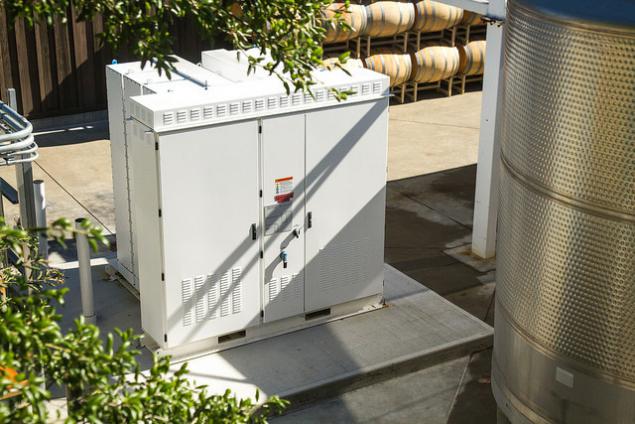
«Tesla, in fact, provide some degree of cooperation" between the electricity supplier and the new battery installed in the Jackson Family Wines, says the publication Ars Mr. Zhervro. He notes that even Tesla took over part of the cost of storage systems for wine. Jackson Family Wines give us some of the money they save on electricity using Tesla, and this amount, it is estimated that of "hundreds of thousands of dollars annually," which was a consequence of the application of the designed system, as well as extensive systems for generating solar power. < br />
The last fight - he was the most difficult h4> Despite the fact that microgrids and differentiated rates are attractive, there's an obstacle in their implementation. The corresponding energy suppliers may not agree to invest in more complex schemes that make it difficult for them to generate revenues.
"This is a stumbling block," - says the publication Ars Mr. Pratt. - "If the micro-network is used only occasionally, and then mainly as an emergency source of electrical power, it makes it easier to prevent blackouts ... But if such a micro-network operated extensively, then it reduces the amount of electricity sold - and reduces significantly».
Similarly, differentiated charging system, which are used to relieve the overloaded network may be an excellent way out of this situation. But if the demand becomes too elastic, suppliers may want to stop to go to such cooperation.
"In order to implement the idea microgrids require at least some restructuring of legal acts, some of which are already undergoing restructuring at the present time", - says Pratt. - "In order to achieve voluntary choice microgrids utility providers, regulatory authorities should allow suppliers to charge higher rates for electricity at peak times, or find other means to motivate them to create new infrastructure».
The thunderclouds found "cluster" of antimatter
Elon Musk is afraid that Google accidentally destroy mankind robots


